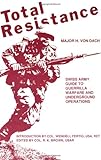For the Drone Menace, well, the people who make, maintain, supply, operate and fly them have to sleep somewhere, sometime. The US has never fought a war where it didn't have a safe and secure far rear area, modulo the Civil War at times, and for the South at the end. No drone can detect someone carrying a concealed firearm, or a small anti-personal IED.
For more, check out this book written after the brutal suppression of the 1956 Hungarian revolution by a Swiss officer at the behest of the nation's Non-commissioned Officer's Association : http://www.amazon.com/Total-Resistance-H-Von-Dach/dp/0873640...
If our betters try this sort of stunt, they'll experience Total Resistance, alright.
Once the SIG SG 510 AKA Sturmgewehr 57 ("assault rifle" in English, but it's really a battle rifle, and at 12.5 pounds edging close to a machine rifle) was adopted in 1957, upon retirement from the reserves, instead of buying your bolt action rifle at a nominal cost, you'd turn yours in and could in return buy one converted to semi-auto.
The new rifle, the SIG SG 550 AKA Sturmgewehr 90 introduced in 1990 is a true assault rifle, but if a [citation needed] bit in Wikipedia is correct, less than 700,000 were produced and "production for the military has now ceased." I've read elsewhere that a quality civilian version of this rifle costs around $3,000, although the cost in bulk buys would be lower (I personally own the closest one can get to this rifle in the US without going to extremes like switching the barrel for a longer one (I deal with the ballistic failures of 5.56x45mm NATO by using illegal for the military hollow point copper bullets from Barnes)).
(In all cases these are reported to be very accurate rifles with issue ammo, drilling a target at 300 meters has always been an important requirement. Switzerland has in general been pioneering here, e.g. adopting non-corrosive primers in 1911, and lead free ones in 1990.)
Somewhat over 600K sounds lower than the able bodied young-45 years of age cohort, and especially if military production has ceased it's pretty clear the system is changing.
I'd also add that there's lots of evidence many in the Swiss establishment were concerned about an invasion by the Soviets post-WWII (e.g. http://www.amazon.com/Total-Resistance-H-Von-Dach/dp/0873640... which is highly recommended), and as a child of the Cold War myself, over in the US, I don't think that concern was unwarranted.
If the law is still requiring nuclear hardened bunkers, that's extremely wise, for we can be sure some day nuclear weapons will be used in anger again.
Final note: Switzerland is instructive in the durability of true federal system, that with the breakdown of ours in the US with steadily increasing centralization of power in our central government, provides some useful object lessons.


Nuclear War Survival Skills, get a PDF to see if it's interesting to you (e.g. http://www.oism.org/nwss/), get the green softcover for when the lights go out and for accurate patterns for the Kearny Fallout Meter: http://www.amazon.com/Nuclear-War-Survival-Skills-Expanded/d... (it says something about the times that Amazon is keeping it in stock, they didn't a few years ago) or from the publisher (previous link).
This is the bible of expedient nuclear war survival, everything from quick to build shelters to sprouting wheat to avoid vitamin deficiency diseases, based on many years of serious research at Oak Ridge, and tested, they'd go so far as to hand a copy of shelter plans to average American families, and then videotape them following the plan, and improve the design based on that. Vs. too many of those classic Civil Defense shelter plans drawn up by bureaucrats in the Beltway that would kill their inhabitants due to too little ventilation to remove heat and humidity.
Maybe then check out his recently published Jungle Snafus ... and Remedies, his hardcore work on survival started in WWII, and he started thinking about nuclear war survival in the mid-late '30s (sic) after learning about the idea of nuclear weapons while at Princeton (quite a few people thought and wrote about it before the details were worked out after E=mc^2 and all that, see e.g. the SF of the pre-end of WWII era).
Then Bruce Clayton's magnum opus, Life After Doomsday, get the Dial Press paperback which has annotations and comments made after the first edition: http://www.amazon.com/Life-after-doomsday-survivalist-disast... And perhaps check out some of his other works, the food for others concept was not, as I recall, originally published in Thinking About Survival http://www.amazon.com/Thinking-About-Survival-Bruce-Clayton/... but you'll find it there (probably originally published in an issue of the hard to find Mel Tappan Personal Survival Letter).
The other two major intellectuals of the era were Jerry Pournelle, see his two relevant novels coauthored with Larry Niven, Lucifer's Hammer and Footfall, and Mel Tappan, start with his Tappan on Survival: http://www.amazon.com/Tappan-Survival-Mel/dp/1581605099/
The obscure and now very expensive used Bad Times Primer by C. G. Cobb had insighs, especially on survival on a budget, I didn't find anywhere else at the time (there is of course the new wave of "prepper" thought and literature that's no doubt worth checking out that might cover things like that): http://www.amazon.com/Bad-Times-Primer-Complete-Survival/dp/...
Finally, Total Resistance http://www.amazon.com/Total-Resistance-H-Von-Dach/dp/0873640... is the manual on sane armed resistance and such, commissioned by the Swiss Non-commissioned Officer's Association, very Swiss vs. USSR invasion and '50s-ish, it's not written by wild eye idiots. Much updating and thought is required, of course, but I would start with that foundation, and for best reading quality, track down the original hardback, I think the publisher reproduced the paperback edition from it.
For modern works, I'll only note The Modern Survival Manual: Surviving the Economic Collapse http://www.amazon.com/Modern-Survival-Manual-Surviving-Econo... since it's written from the author's experience of a less than total collapse in Argentina. See also people's writeups of the much worse collapse and warfare in post-Cold War Yugoslavia.